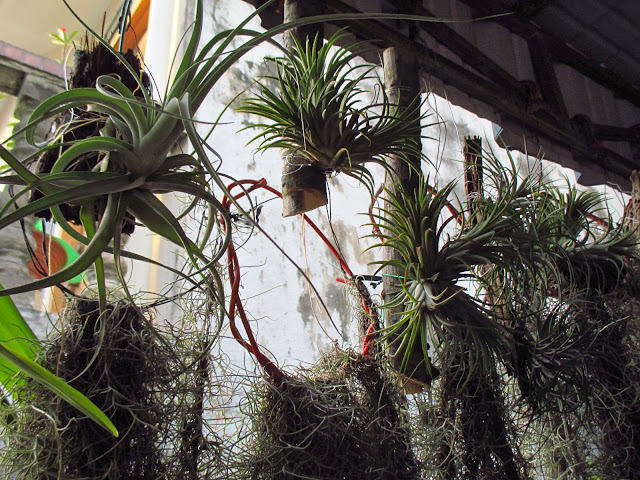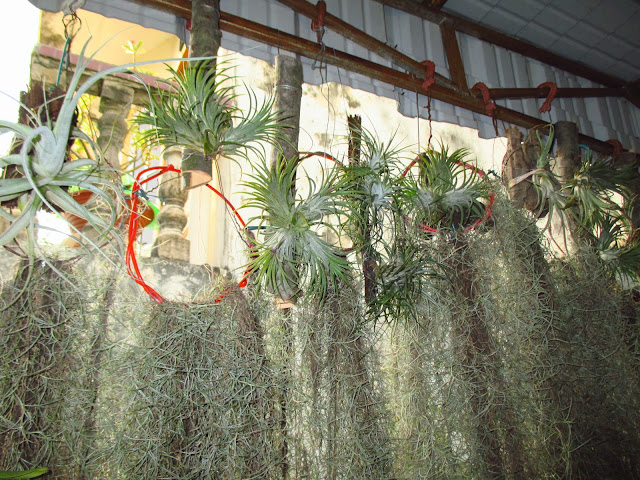Airplants are an acquired taste for gardeners.
They may appear to be some sprigs of pines put together in a bunch.
An appearance not more that a pineapple crown
(well - they are actually from the same genes - bromeliads)
and to top it off - they are indeed expensive.
Yeah... I wouldn't recommend it for new beginners.
(unless you are the adventurous type)
But if you get it from a friend to try your hand on it or
perhaps you manage to get them for a good price - (then what-the-heck. Go for it.)
Aren't gardening is all about risk.
I think I had mentioned in my earlier post about this one:
(click below for link)
Tillandsia Ionantha.
(Above pic)
I manage to get two hangers for RM35.00 each.
Each has 10 florets in a hanger.
These can fetch RM25.00 each florets - if they are sold singularly.
(That is 20 pieces to experiment with - Woohooo!!!)
They had recently had finished blooming and I need to separate them as they are tightly knot together back to back (no new growth space)
Also noticed that the leaves seemed to snap and break easily due to the fact that they have limited movement as are so tightly compacted together.
The story goes that I had spotted a tree felled due to heavy rain and it was cut down into small sizes and left on the roadside. I manage to pick up few branches and saw them in arms length (ohh.. the sawing took forever)
I manage to break up the existing clumps and set them on these new logs.
I found that the "mother" plant had died and dried up and these are her offsprings.
The new grand-children are already peeking out in between the leaf crevices.
Here I fixed 3 to 4 clumps together.
And the last branch 4 pieces individually.
I wanted to have a these big species hanging above the Spanish Moss to give that dramatic effect.
(Big fellas like roses and cascading effect like curtain from the other kind)
Also I made sure that nothing touches the Spanish Moss as it can damage them badly.
Some additional info concerning Spanish Moss.
(That is if you like Spanish Moss to hang loose like this cascading effect, or more like a hair)
I had seen some gardeners manage them in a tight space (more like a tight spot)
These somehow I notice that they had matured and curled up with many little spawns with a dried up bunch barely hanging on them. The mass is very much had dried up but the surviving factor is that new "babies" had attached itself on them.
I'm pretty sure most gardeners having these would had abandoned the very idea of "clearing the mess". It is indeed a want not - throw not issue and something that anyone would come to realise that it would put one gardener in an ignorance box
(see not - worry not) factor.
Personally some gardeners whom I knew, ascribe a strong attitude:
If the plant manage to survive in the garden - then it is meant to be.
My comment: (Poor plant)
And I passionately feel for the plant and for the heart-aches of the gardeners who owns this plant.
The best I can offer is advice and encouragements.
And above all - DON'T GIVE UP.
I had addressed most of the comprehensive information
on my earlier write-up on this topic. Click on the title for the link:
Tips to Grow Spanish Moss
So coming to the additional tips:
If and when you purchase this plant and that you find them fastened on a round secular wired hangers - do consider taking the trouble to rewrite them for your watering purposes.
The ones sold in nurseries often comes in a circular hangers where the plant is fastened all around.
The problem with this is that it causes a low or non-effective watering factor.
Most gardeners who have no time or challenged by it were only able to water their garden minutes before rushing to go to work or late in the night.
And so the watering regime (or routine - whatever you want to call it) ends up spraying at the top front (what appears to be facing the gardener - spraying them with the hose) and those which are the back are neglected.
To this effect, over time you will find the strand which had not watered will dry up and withered away and the areas which is heavily watered will have top heavy position where few stands had taken the colony of this Spanish Moss
(hanging by that foundation)
I hope you get the idea of what I'm trying to say.
What appeared to be the newly bought equally circular hanging bunch will end up tilting unevenly to one side as it becomes heavy due to rapid growth but decline on the other irregular watered side.
Do rewire them like the ones I posted here in the picture.
Hang them as you would hang a scarf.
When watering - spray on the top of the holding place and let the water cascade downwards easily.
It should not be facing any obstacles (hitting against any branch, pots, etc)
It must be an easy flow.
Imagine - its like a hair.
A clean flowing hair promise a nice clear straight growth.
A messy crumpled, cramped plant means simply that - a messy growth.
Spanish Moss do grow in large volume cascading more branches downwards.
So they need more space to spread and grow more freely.
Hampering that growth will lead to stress and the plant will dry up immaturely.
These are the pieces of Spanish Moss that often falls of from the main hanger.
They happen to be coming of from the dried off sectors.
Here I collect them and tie them up with a string and loop them back to the main hanger.
(Why waste them - give them the opportunity to survive & grow too)











































































